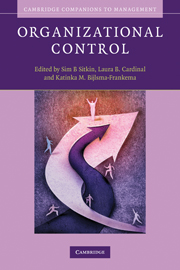Book contents
- Frontmatter
- Contents
- List of figures
- List of tables
- Contributors
- Foreword
- Part I Introduction and history
- Part II Conceptions of organizational control
- 3 A configurational theory of control
- 4 Critical perspectives on organizational control: reflections and prospects
- Part III Identity, attention, and motivation in organizational control
- Part IV Relational control
- Part V Managerial and strategic control
- Index of terms
- Author index
- References
4 - Critical perspectives on organizational control: reflections and prospects
Published online by Cambridge University Press: 05 June 2012
- Frontmatter
- Contents
- List of figures
- List of tables
- Contributors
- Foreword
- Part I Introduction and history
- Part II Conceptions of organizational control
- 3 A configurational theory of control
- 4 Critical perspectives on organizational control: reflections and prospects
- Part III Identity, attention, and motivation in organizational control
- Part IV Relational control
- Part V Managerial and strategic control
- Index of terms
- Author index
- References
Summary
Critical perspectives on organizational control begin with the recognition that organization is neither inevitable, nor a given subject only to efficiency requirements. Actors are conceived as knowledgeable agents with potentially divergent motives and interests and organization is seen as socially constructed and political in its nature. Thus in shorthand terms, while wary of simplistic dichotomies, one might position critical approaches in distinction to “mainstream” or functionalist accounts of organization on a number of counts. Radical approaches of various hues emphasize the relationship between the design of work, control, and the nature of economy and society within which organization occurs. Early critique, informed by readings of Marx, challenged conventional assumptions that the design of work and patterns of employment were “created” by the scientific, technological, and organizational advances of the industrial revolution and as such “neutral” or “appropriate” in response to prevailing economic conditions (Fox, 1974; Marglin, 1974). These analyses sought to locate developments within wider patterns of asymmetrical power relations and material outcomes.
Early critical work centered on the labor process, the changing nature of skills, and the degradation of power and social positions of workers (Braverman, 1974). Edwards (1979) argued that to understand the underpinning reasons for workplace hierarchy and the transformation of the labor process during the late nineteenth and early twentieth centuries, scholars needed to focus on the characteristics of the economic system, that is, capitalism.
- Type
- Chapter
- Information
- Organizational Control , pp. 80 - 108Publisher: Cambridge University PressPrint publication year: 2010
References
- 4
- Cited by

